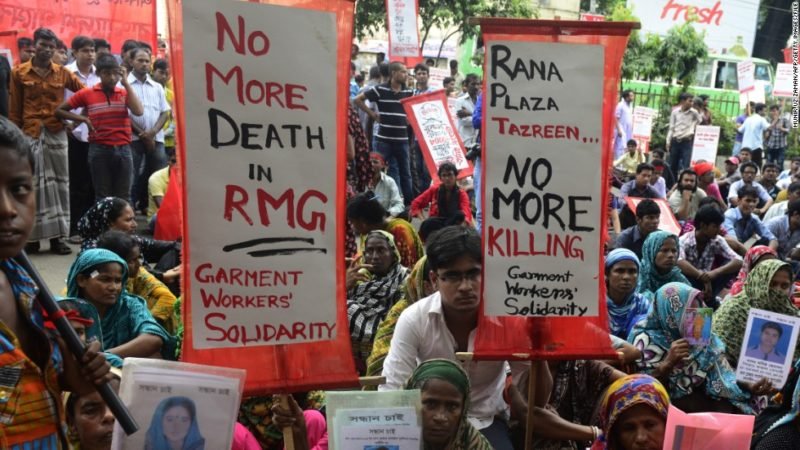Sustainable Fashion: An Ethical Future Ahead?

Fashion is one of the most polluting industries and one of the most influential one. Currently, total greenhouse gas emissions from textiles production, at 1.2 billion tonnes annually, are more than those of all international flights and maritime shipping combined, that’s really alarming. By some estimates, emissions in this sector is expected to rise by more than 60% by 2030. In 2015 two large agreements realized the way to where we have to go, what direction to take and what we need to do to live in a more sustainable planet, this is how the 2030 Agenda for Sustainable Development and the Paris Agreement on climate change adopted. But when we talk about the SDGs and fashion we also refer to the human and labour exploitation of textile production, because sustainability must be analyzed around its three dimensions, i,e. social, economic and environmental. We can meet our needs without accumulating things and buying what we don’t need, without compromising with resources and possibilities for future generations. We have innovative ideas and this is our opportunity to take care of our planet because there is no planet B.
Fashion industry
The textile industry has its origin in the Industrial Revolution in Great Britain between the end of the 18th century and the middle of the 19th century, where the economic model based on agriculture, commerce and artisanal production forms became dependent on industrial processes. This industry was the first to develop, leaving behind the domestic system of tissue production from wool and cotton that was woven to make fabrics and then finish the product. The changes that were generated with the Industrial Revolution were technological, social, economic and cultural, where textile production began to be produced in factories thanks to hydraulic power or steam engines. In 1889, Isaac Singer (American inventor) was the one who built the first electric sewing machine, although textile production in Britain already had several years of economic development with artisanal manufacturing methods.[1]
Over centuries the textile industry was growing at large scale and was developing worldwide, thanks to the cheap labour and outsourcing. Today we see that since the Industrial Revolution human activity has generated large concentrations of carbon dioxide and other greenhouse gases in our atmosphere, causing global warming, industrial disasters, and illegality of textile workers who are forced to accept poor working conditions due to their basic survival necessities.
On April 24, 2013, there was a collapse in a building in Dhaka, Bangladesh, where textile manufacturing workshops were operating, it was a catastrophe that alerted the international community about what was happening in the fashion industry, marking a before and after. Surely, it is not the only place where it happened and continues to happen, only that this news crossed the borders awakening the interest of all to reverse this problem. Therefore, those of us who promote sustainable or ethical fashion consider it very important to start from the dimensional concept of sustainability: social, economic and environmental, which seeks to create designs and trends based on environmental care and social responsibility, with the main objective of sustainable design considering its impact throughout the value chain from its life cycle to its carbon footprint. On the contrary, the fast fashion that develops the production on large scales allows the increase of mass consumption based on criteria of trends that change in each season with different autumn-winter, spring-summer collections. Many times we tend to imitate these fashion trends through production and sales at a low cost without taking into account the damage to the environment or the working conditions of the labours.[2]
This new way of seeing fashion began with different movements, environmental organizations and fashion designers, who decided to analyze what happens during the supply chain, and thus look for the practical alternatives to the mass consumption of clothing, among them we, can mention Fashion Revolution, Doconomy, Slow Fashion Next, Gema Gomez, Lucy Siegle, Vivienne Westwood. Currently, summits and conferences on Sustainable Fashion are held worldwide as “Study Hall: Sustainable Fashion Conference. Sustainability as a culture”; “Global Sustainable Fashion Week”; “Fashion Summit.”

The fashion industry is the second-largest sector polluting the planet, with the highest water consumption considering the water footprint, generates 20% of the world’s wastewater, in addition to releasing half a million tons of synthetic microfibers to the ocean every year by increase in the consumption of single-use garments (wear for a short period of time and then discard), that was generated during the last 15 years. In the same way, the textile industry is responsible for between 8% – 10% of carbon emissions, which is more than international flights and maritime transport combined. On March 14, 2019, the United Nations established an Alliance for Sustainable Fashion that sought to show the damage of “fast fashion”, practices that are harmful to the environment and society. This Alliance is working collaboratively with the UN agencies to find solutions and make fashion more sustainable. Likewise, a dialogue platform was created to promote the so-called “Blue Fashion” by the Food and Agriculture Organization, which uses sustainable marine materials and tends to protect arable land during the textile production process. On the other hand, International Trade Center established a project on “Ethical Fashion” with the participation of artisans from developing countries and UN Environment is pressing for governments to take concrete political actions to achieve the objectives and try to promote sustainable textile manufacturing practices.[3]
According to the UN Conference on Trade and Development (UNCTAD), the fashion industry generates 10% of global greenhouse emissions, due to high energy consumption and long supply chains. In addition, the United Nations Framework Convention on Climate Change (UNFCCC) suggests, textile production has a great impact on Climate Change as more energy is needed than in other industries such as aviation or maritime transport. However, the impact generated by the fashion industry goes beyond the global carbon emissions only, as it also generates 20% of wastewater and 85% of textiles end up in landfills or are incinerated, only collecting the 20% for reuse or recycling. Also, an environmental study warned that making jeans requires the use of 7500 litres of water, which is equivalent to the amount an average person drinks in 7 years, which we think is incredible but it is the cost we pay to be in the “fashion”. Statistical data obtained at UNCTAD indicated that the clothing sector uses 93,000 million cubic meters of water for its preparation, which could meet the needs of 5 million people. In addition, half a million tons of microfibers, the equivalent of 3 million barrels of oil, are thrown into the sea, since synthetic fibres are obtained from various petroleum products such as nylon, polyester, spandex. The supply chain and manufacturing processes contain very high global emission rates as the fashion industry consumes large natural resources for its production. In total, the production of clothing and footwear generates 8% of greenhouse gases. [4]
UN interest in order to achieve the 2030 Agenda for Sustainable Development Goals also reaches sustainable fashion.
The UN Climate Change promotes sustainable fashion through “Climate Neutral Now”, where organizations wishing to offset carbon emissions with investments in projects in developing countries are invited. It also calls for global climate action “Act Now,” where the United Nations calls for individual action on climate change. This campaign aims to raise awareness, ambition and action to accelerate the implementation of the Paris Agreement. It is an online and social media campaign to educate and encourage sustainable consumer actions. The idea of “Act Now” is that all the people in the world commit to making a difference in every aspect of their daily life, from the food they eat to the clothes they wear, so in 2019 it focused on the basis of Food and the “Fashion”! On the latter, everyone is invited to carry out “zero waste” fashion actions through a challenge: recycle old clothes and create a new look. Thus, the best fashion designers will present their own recycled collections, generating a creative wave so that everyone is encouraged to create their own recycled designs and share on social networks.[5]
How do the SDGs contribute to sustainable fashion?

The word “sustainability” first appeared in 1987, with the “Brundtland Report”, named after the name of Dr. Gro Harlem Brundtland (former Prime Minister of Norway), who was in charge of a World Commission on Environment and Development in charge of investigating, studying and looking for solutions to environmental problems as a result of anthropogenic activities. This report, also known as “Our Common Future”, was Prepared by several UN countries, there appeared for the first time the concept of “Sustainable Development”, defined as that development that allows us to meet our needs without compromising with the future generations.
In September 2015, the United Nations General Assembly approved the 2030 Agenda for Sustainable Development to which the 193 member states subscribed, based on three dimensions of sustainability: economic, social and environmental, formally entered with effects from January 1, 2016. State leaders accepted a set of global objectives called “Sustainable Development Goals” (SDGs) in order to eradicate poverty, protect the planet and ensure prosperity for all as part of a new sustainable development agenda. These objectives are a road map and act as a state of alert for the world to make evolution by committing itself in a more sustainable way, in terms of daily life. The SDGs are 17, each of them expressing an objective that it aims to achieve, in turn, there are 169 goals, where each objective includes a series of globally defined guidelines and has 230 indicators proposed by the Inter-agency and Expert Group on SDG Indicators (IAEG-SDGs) for monitoring and reviewing the global progress of the 17 SDGs.
With these new objectives of universal application, the states pledged to intensify efforts for the next 15 years to end poverty in all its forms, to reduce inequality and fight against climate change, while achieving development all of us will become part of the common goals in order to meet the 17 objectives of shared global values and of which all must do their part; Governments, the private sector, civil society, NGOs.
Of the 17 objectives proposed by the new Global Agenda, three are closely related to sustainable fashion, SDG 8 “Decent work and economic growth”, SDG 12 “Responsible consumption and production” and SDG 13 “Climate action”.[6]
SDG 8 “Decent work and economic growth”. Promote inclusive and sustainable economic growth, employment and decent work for all.
The number of workers who still live under vulnerable conditions and extreme poverty are close to half of the world’s population, living on less than $2 a day, 5.7% are unemployed. The great challenge to achieve sustainable economic development is the creation of quality jobs, the eradication of poverty, and the care of the environment. Sustainable economic growth promotes technological innovation and increased productivity to meet the SDGs. Public policies are needed to stimulate the creation of jobs, the private sector and companies to eradicate forced labour, slavery and human trafficking. Likewise, the working conditions that some workers in the fashion industry have led to think that they are forms of “modern slaves” since, organisations they work, do not respect the labour standards established by the ILO.
“Law on company surveillance” (Law 2017-399, of March 27, 2017). France an emblematic case:
In 2017 France adopted a surveillance law for companies, which has a due diligence obligation for French companies that have more than 5,000 employees in France or more than 10,000 employees worldwide including subsidiaries, suppliers and subcontractors regardless of What part of the world they are. This is the first legislation at the international level that contemplates, the principle of the duty of surveillance by companies. This law is based on the “United Nations Guiding Principles on Business and Human Rights”, which states that governments are primarily responsible for ensuring that companies respect the environment and human rights, through the identification of risk and responsibility throughout the value chain.[7]
SDG 12 “Responsible consumption and production”.Ensure sustainable consumption and production patterns.
This is one of the 17 Global Objectives of the 2030 Agenda for Sustainable Development, which poses a comprehensive look to advance and meet the other objectives. We must reduce the ecological footprint to achieve economic growth and sustainable development, for this it is necessary to change the forms of production and consumption of goods and natural resources. It is also important that industries, businesses and consumers choose recycling measures to reduce and reuse waste, support and cooperate with developing countries so that they can achieve the objectives set out in the 2030 Agenda. Each product we buy has an environmental footprint; the impact of plastic pollution is reflected in terrestrial and marine life.
SDG 13 “Climate action”.Take urgent action to combat climate change and its impacts.
When we talk about climate change we mean multiple threats that are the greatest challenges that humanity must face, and that is more than a goal of sustainable development. The impact of climate change will mean more frequent extreme weather events, and more people displaced by these events, sea levels will continue to rise, affecting smaller islands and lower coastal areas, and many places will experience longer droughts, threatening food, Ecosystems and water supply. Climate change knows no borders and is affecting all countries of the world, causing disturbances in national economies, in people’s social lives, many extreme events that are increasing and greenhouse gas emissions have reached the highest levels History highs. Climate action is an urgent call for all and we must act now because the risks of climate change are essentially global, no matter where pollutant emissions are generated they will always affect some region of the world. It is raised like this, the need to act with a long-term perspective, starting today, because the most vulnerable countries are the most affected by this problem. Our greatest challenge is to achieve international climate cooperation where progress can be made towards a low carbon economy.[8]
That is why we believe it is important that from the UN, NGOs and companies are committed to the sustainable fashion movement that is gaining increasing importance worldwide. Europe has a strong action on this issue, as many multinationals are betting on ethical fashion. However, in other regions, it is also developing as in Kolkata, India this brand “LataSita”, which creates zero waste recycled clothing, respectful of the environment.
The Paris Climate Agreement also invites us to create sustainable fashion
On December 12, 2015, in order to strengthen the global response to the 195 nations, they met in Paris and reached a historic agreement: the Paris Agreement (COP21) to combat climate change, promote future measures and investments Low in carbon emissions, resilient and sustainable. This Agreement entered into force in November 2016 for countries that decided to ratify it in order to strengthen the global response to the threat of climate change. It is an agreement within the United Nations Framework Convention on Climate Change (UNFCCC) that deals with the mitigation of greenhouse gas emissions, adaptation and finances with a roadmap completed by the year 2020. All nations committed to a common cause based on their historical, present and future responsibilities. The main objective of the universal agreement was to keep the global temperature rise below 2 degrees Celsius and limit the temperature rise even below 1.5 degrees Celsius above preindustrial levels.
As a consequence, the UN is helping more companies in the textile sector to transform themselves towards sustainable businesses that allow them to fight against climate change and achieve the Sustainable Development Goals. The fashion industry causes 10% of global greenhouse gas emissions, due to the large energy consumption it demands and the large supply chains. It is key that there is a change in textile industry practices to reduce carbon emissions near 1.5 degrees Celsius above the levels of the Industrial Revolution, as indicated by the Paris Agreement.[9]
Working with the SDGs is to make a revolution in the fashion industry because it is to look for a more sustainable way, friendlier with the environment and the planet, thinking about future generations. The 17 Objectives are interrelated, which makes the success or failure of one affect the rest, so we believe that sustainability must be transformed in the way we live, be more responsible and aware. We have created consumption habits where we look for practicality and the lowest cost when choosing what we want, which seems consistent, the problem is that we have forgotten what is the damage we cause to the environment when we follow these practices, what are its ecological implications, this damage of the fashion industry is not only ecological, but humanitarian. Human Rights and Labour Laws must be respected.
Reaching zero net greenhouse gas emissions will require changes in human activity, both the way we produce and how we consume them, it is better to buy what we need and choose well. Many brands, designers and even environmental activists have opted for sustainable fashion knowing the impact that the fast fashion industry is generating and its relationship with climate change. If the fashion industry made better quality clothes, and that lasts longer we would not need to buy much to have more and accumulate. We are all responsible and can contribute to achieving the objectives of the 2030 Agenda and Paris Agreement. There is no time, it is now, and it is “Time to act”.
[1]Indrajit Ray, “The Development of Modern Industries in Bengal: ReIndustrialisation, 1858–1914”. Edit. Routledge, 2018.
[8]Alieto A. Guadagni y Miguel A. Cuervo, “El cambio climático. Un desafío mundial”. A Edit. El Ateneo, 2017.



















